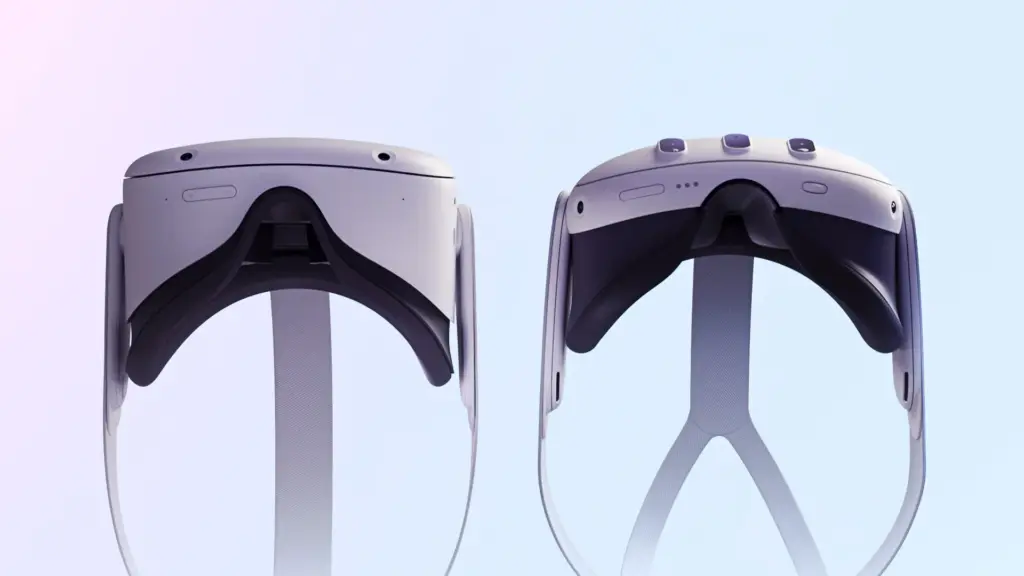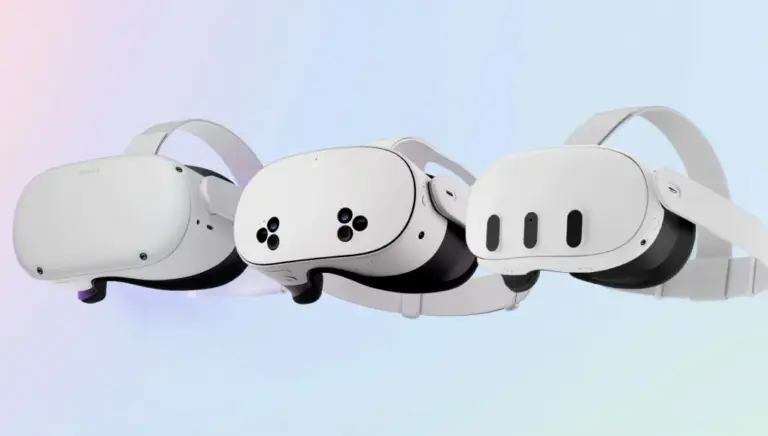Quest VR Comparison: Quest 2, Quest 3, and Quest 3S Specs Analysis

Exploring the Quest Series of VR Headsets
The world of virtual reality (VR) has evolved impressively with the launch of models such as the Quest 2, Quest 3, and the newly released Quest 3S. Each headset introduces distinct features that make understanding their specifications vital to finding the perfect match for your VR needs. In this blog post, we provide a thorough Quest VR comparison, focusing on the differences and similarities among these three headsets.
Key Specifications Review
Specifications form the backbone of VR headsets and influence overall performance. Let’s explore the essential aspects of the Quest series.
Quest VR Comparison : Comparing Display Quality
The quality of the display in a VR headset significantly enhances the immersive experience. Here’s a comparison of the display features across the models:
- Quest 2: Boasts a resolution of 1832 x 1920 pixels per eye. While this resolution offers satisfactory clarity, it may feel a bit outdated next to the latest models.
- Quest 3: Upgrades this to 2064 x 2208 pixels per eye, providing sharper images and a visually richer experience.
- Quest 3S: Retains the impressive resolution of the Quest 3, ensuring high-definition visuals that cater to all types of media.
Processor Performance Evaluation
Processing power is another pivotal aspect in the Quest VR comparison. Each headset features its own chipset, affecting overall performance.
- Quest 2: Comes with a Snapdragon 865 processor. While it was powerful upon release, it struggles to keep up with demanding applications.
- Quest 3: Utilizes the upgraded Snapdragon XR2 Gen 1 processor, leading to faster loading times and smoother frame rates.
- Quest 3S: Keeps the XR2 Gen 1 processor, which ensures similar performance enhancements as the Quest 3, providing a seamless experience.
Examining Tracking Capabilities
Accurate tracking is crucial for a truly engaging VR experience. Let’s assess how each model performs in terms of tracking:
- Quest 2: Offers 6DOF tracking, which provides decent motion detection, but may not deliver the highest accuracy.
- Quest 3: Features advanced sensors, enhancing positional tracking and minimizing latency.
- Quest 3S: Matches the impressive tracking abilities of the Quest 3, ensuring users enjoy a responsive and immersive experience.
Comfort and Ergonomics in Design
Comfort plays an essential role, especially during extended VR sessions. Here’s how these models fare regarding comfort and design:
- Quest 2: Lightweight design; however, users have reported discomfort during extended usage due to the foam interface.
- Quest 3: Enhances ergonomics, improved weight distribution, and offers a more comfortable facial interface.
- Quest 3S: Retains the design improvements introduced with the Quest 3, prioritizing user comfort during long gaming or entertainment sessions.
Audio Quality Analysis
The audio experience is vital for immersing users in the virtual environment. Here’s how the models stack up for audio performance:
- Quest 2: Equipped with built-in speakers, it delivers acceptable audio quality, albeit lacking in deeper bass.
- Quest 3: Elevated audio performance, featuring spatial audio capabilities that significantly enhance the immersive experience.
- Quest 3S: Continues to offer the superior audio quality of the Quest 3, ensuring an engaging sound environment.
Comparing Battery Life
Battery life is a critical component, especially for gamers and content creators. Here’s a brief overview of battery performance across the models:
- Quest 2: Provides a battery life of around 2-3 hours, which might be limiting for prolonged sessions.
- Quest 3: Slightly enhances battery longevity, allowing for longer enjoyment on a single charge.
- Quest 3S: Matches the Quest 3’s battery performance, making it reliable for extensive use.
Pricing and Value Considerations
Pricing often influences decisions when selecting a VR headset. Here’s a brief overview of the costs:
- Quest 2: Initially offered as a cost-effective choice, it remains the most budget-friendly option among the trio, appealing to new users.
- Quest 3: Positioned at a higher price point but justifiable due to improved specifications and features.
- Quest 3S: Priced similarly to the Quest 3, continuing to provide excellent value for enhanced features.
Making the Right Decision in the Quest VR Comparison
Deciding between the Quest 3S, Quest 3, and Quest 2 comes down to individual preferences and budgets. While the Quest 2 serves as a solid entry-level option for VR newcomers, the Quest 3 and Quest 3S cater to users seeking advanced features and performance enhancements. Whatever your decision may be, each headset offers unique advantages that can greatly enhance your virtual reality experiences.
| Quest 2 | Quest 3S | Quest 3 | |
| Display | 1 × LCD | 1 × LCD | 2 × LCD |
| Resolution (per-eye) | 1,832 × 1,920 (3.5MP) | 1,832 × 1,920 (3.5MP) | 2,064 × 2,208 (4.5MP) |
| Pixels Per-degree | 20 PPD | 20 PPD | 25 PPD |
| Maximum Refresh Rate | 120Hz | 120Hz | 120Hz |
| Optics | Fresnel | Fresnel | Pancake |
| Field-of-view | 96ºH × 90ºV | 96ºH × 90ºV | 110ºH × 96ºV |
| Pass-through view | Black & white (4 PPD) | Color (18 PPD) | Color (18 PPD) |
| Optical Adjustments | Stepped IPD eye-relief (via included spacer) | Stepped IPD eye-relief (via included spacer) | Continuous IPD, stepped eye-relief (built-in) |
| IPD Adjustment Range | 58mm, 63mm, 68mm | 58mm, 63mm, 68mm | 53–75mm |
| Performance & IO | |||
| Processor | Snapdragon XR2 Gen 1 | Snapdragon XR2 Gen 2 | Snapdragon XR2 Gen 2 |
| RAM | 6GB | 8GB | 8GB |
| Storage | 128GB, 256GB | 128GB, 256GB | 512GB (128GB previously available) |
| Connectivity | Wi-Fi 6, Bluetooth | unknown (likely Wi-Fi 6E, Bluetooth) | Wi-Fi 6E, Bluetooth |
| Connectors | USB-C | USB-C | USB-C contact pads for optional dock |
| Input | Touch v3 (AA battery 1×) hand-tracking, voice | Touch Plus (AA battery 1×) hand-tracking, voice | Touch Plus (AA battery 1×) hand-tracking, voice |
| Audio | In-headstrap speakers 3.5mm aux output | In-headstrap speakers | In-headstrap speakers 3.5mm aux output |
| Microphone | Yes | Yes | Yes |
| Battery | 1.5–2.5 hours (3,640 mAh) | 2.5 hours (4,324 mAh) | 2.2 hours (5,060 mAh) |
| Weight | 503 grams | 514 grams | 515 grams |
| Sensing | |||
| Headset-tracking | Inside-out (no external beacons) | Inside-out (no external beacons) | Inside-out (no external beacons) |
| Controller-tracking | Headset-tracked (headset line-of-sight needed) | Headset-tracked (headset line-of-sight needed) | Headset-tracked (headset line-of-sight needed) |
| Eye-tracking | No | No | No |
| Expression-tracking | No | No | No |
| On-board cameras | 4 × IR | 2 × RGB, 4 × IR 2 × IR flood LED | 2 × RGB, 4 × IR |
| Depth-sensor | No | No | Yes |
| Price | |||
| MSRP | $300 (128GB), $350 (256GB) | $300 (128GB), $400 (256GB) | $500 (512GB) |




0 Comments